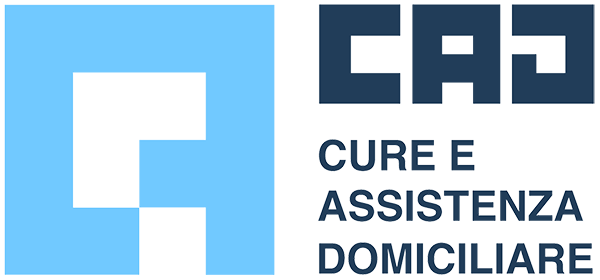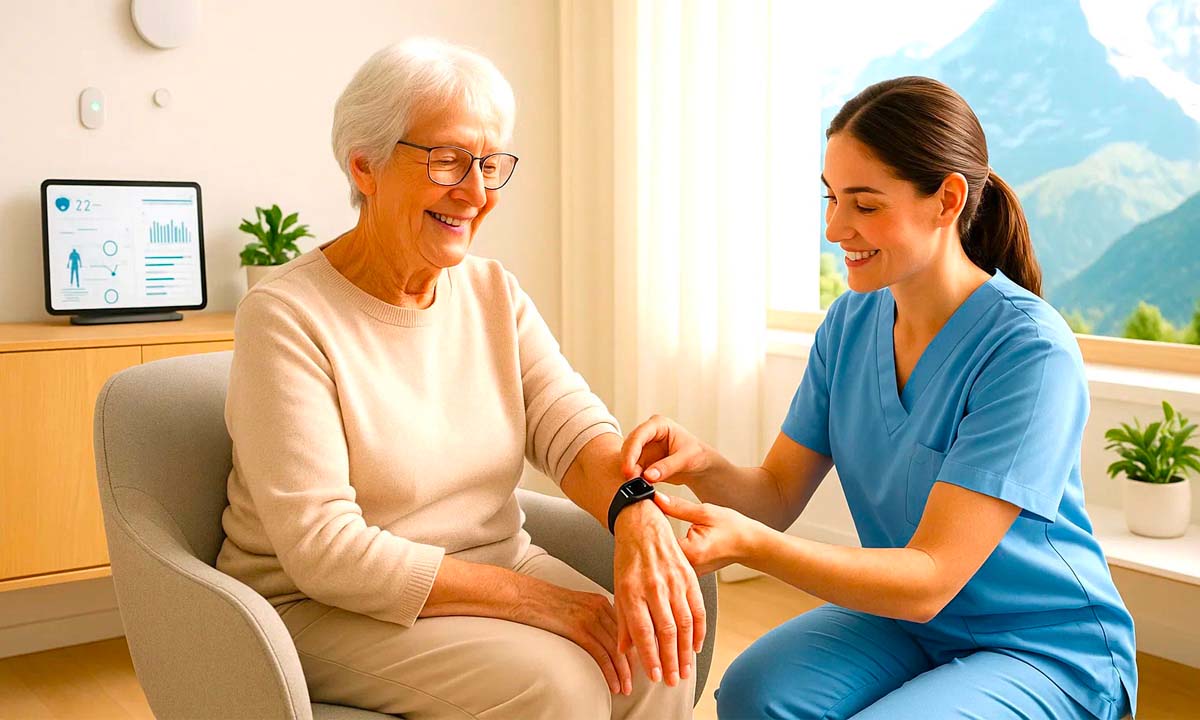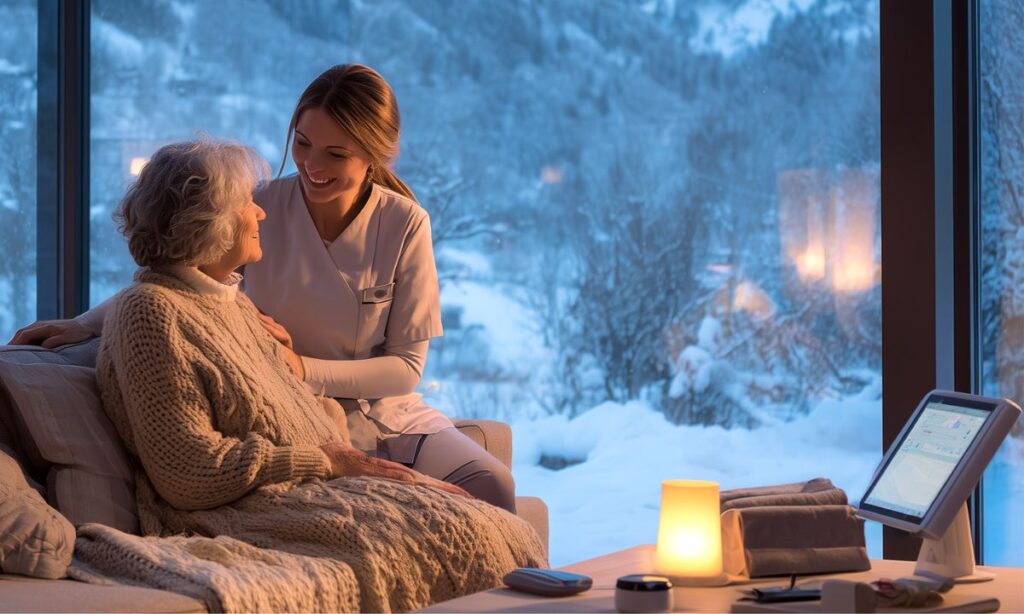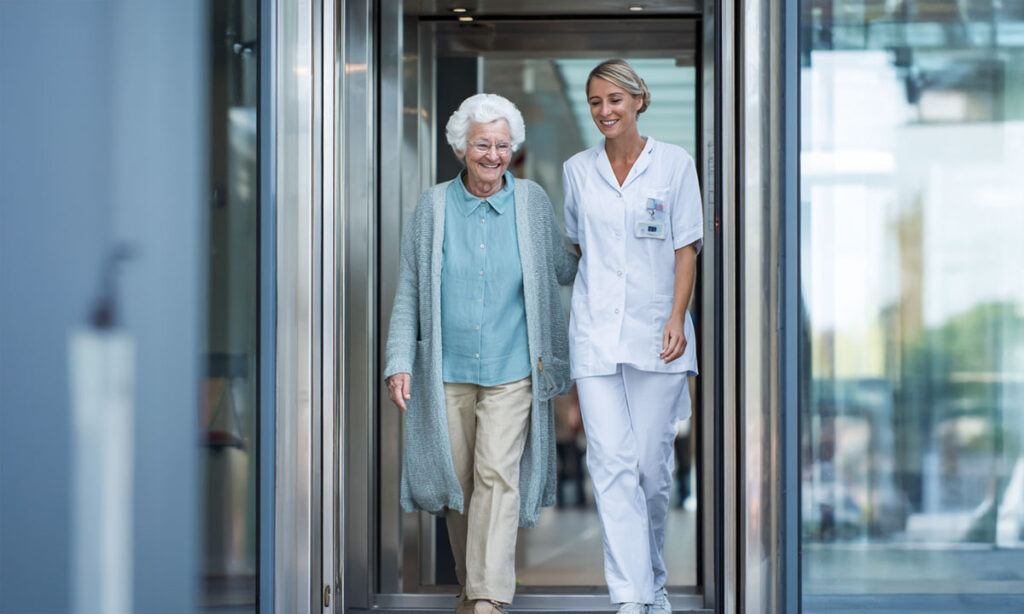What is Tele-assistance?
Tele-assistance is a vital assistance service that offers safety and security to elderly and vulnerable people living alone. It is a technological solution that allows users to call for help in an emergency with a simple gesture, thanks to a wearable device, such as a bracelet or pendant, equipped with an SOS button. This system is designed to ensure rapid response in critical situations, such as illness, falls, or accidents in the home, reducing the risks associated with delayed assistance.
How is Tele-assistance activated in Switzerland?
In the canton of Ticino and Italian-speaking Grisons, remote assistance is particularly well developed and integrated with emergency services. When a user presses the SOS button, the call is automatically directed to the 144 emergency operations center. Dedicated, highly trained operators assess the situation and immediately organize the necessary assistance and care. The response chain includes the immediate dispatch of an ambulance or a call to a reference number provided by the patient, which is often a close relative or SPITEX. A crucial aspect of this system is the possibility of two-way communication: if the user is near the loudspeaker connected to the device, they can speak directly to the operator to describe what has happened. Even in the absence of verbal communication – for example, if the person has fainted or is unable to speak – emergency services are still activated without delay.
Tele-assistance: assistance for the elderly and frail patients
Currently, in Ticino and Italian-speaking Grisons, the tele-assistance service has over 3,000 users. Most of these are elderly people, but the system also supports younger people with disabilities or medical conditions that make them vulnerable. This service not only offers security to users but also brings peace of mind to their families, who can rest assured that their loved ones have immediate access to help in case of need. At a time when the aging population is a growing reality, Tele-assistance is an indispensable tool for promoting the well-being of the elderly by offering them greater independence at home and safeguarding their safety.
Technological advances in Tele-assistance: telemonitoring
Tele-assistance has undergone an extraordinary technological evolution in recent years, evolving from simple devices to advanced solutions that integrate innovative features. In the past, the concept of Tele-assistance was embodied by basic devices such as the first bracelets and lifesavers, which allowed users to send an emergency signal with a single function: to alert emergency services. Today, however, modern systems use sophisticated technologies that greatly expand the possibilities for remote assistance by providing advanced home care.
From emergency calls to continuous telemonitoring
A prime example of this evolution is the “Healthcare Watch” from CAD (Home Care and Assistance) in Ticino. This device (which is medical grade, unlike the various smartwatches on the market that are not) is not limited to the traditional SOS button, but integrates a series of advanced features that make it a true continuous telemonitoring tool.
he main features of this innovative telemedicine device include:
- Automatic fall detection: thanks to integrated sensors, the watch is able to recognize a fall independently and activate an alarm, even if the user is unable to press the button. This is particularly useful in situations where the person is unable to activate the SOS alarm spontaneously, for example, following accidental falls and loss of consciousness or in situations of immobility caused by contusions/fractures.
- GPS and geofencing: the device includes a geolocation system that allows you to track the user’s position in real time. Geofencing also allows you to set a customised virtual perimeter: if the user, for example, a person with cognitive impairments such as Alzheimer’s disease, leaves this safety zone, the operations centre is immediately alerted. The alarm perimeters are always agreed upon with the patient and/or family members.
- Vital sign monitoring: the Healthcare Watch is equipped with sensors that record data such as heart rate and oxygen saturation at customized intervals and transmit it to the operations center 24/7. This allows the user’s health to be monitored proactively. Thanks to a highly customizable system, it is also possible to set threshold values and, if these are exceeded, the operations center receives alarms that allow operators to assess the situation and coordinate any interventions.
- Two-way communication: as in traditional systems, the user can speak directly to operators, but modern technology makes this interaction smoother and more reliable because it works by connecting to the mobile network and not just to the home wireless network.
The system, therefore, also allows the features listed above to function outside the home and within the borders of Switzerland.
These innovations transform remote assistance from a simple emergency tool into a comprehensive monitoring system capable of responding to a wider range of needs and situations. The ability to anticipate problems through continuous monitoring and predictive technology represents a significant step forward.
Discover CAD’s enabling technologies
Remote assistance and home care: Integration with CAD services
One of the most innovative aspects of the service offered by CAD is the integration of remote assistance with specialized home care. This approach goes beyond simply activating traditional emergency services and introduces a more flexible and personalized care model. When a user sends an alarm via the device, the CAD operations center does not simply contact the 144 ambulance service: it also has a specialized nursing team available 24 hours a day, capable of reaching the user’s home within 20 minutes of the alarm being raised.
This integration is particularly valuable in situations that do not require immediate hospitalization. For example, if a user presses the SOS button for severe pain, mild discomfort, or a non-urgent need for medical assistance, the CAD team can send a nurse directly to their home. This allows the problem to be resolved on site, avoiding the inconvenience and stress of a trip to the emergency room. In more serious cases, however, collaboration with the main emergency services in the area ensures a coordinated and timely response, with the intervention of emergency doctors or the organization of hospitalization when necessary.
The advantages of an integrated assistance service
- Speed of response: the ability to send a nurse within minutes speeds up response times, reducing the risk- of complications.
- Tailored assistance: the initial assessment by the control center allows the response to be adapted to the type of emergency, ensuring a more targeted approach.
- Integration into the healthcare network: the connection with local emergency services creates a fluid and well-structured system in which every level of care is coordinated.
- Reducing situations involving prolonged waiting times for assistance: avoiding situations in which the patient requires emergency assistance but, due to an inability to alert the emergency services, fear, agitation, or cognitive impairment, the patient faces prolonged waiting times before the arrival of an operator.
This model represents an evolution of the traditional concept of Tele-assistance, transforming it into an active component of a broader, more integrated care system.
Discover all CAD services
Benefits of Tele-assistance for users and caregivers
Tele-assistance, especially in its advanced form as offered by CAD, also offers concrete benefits to both users and their caregivers. For those who use it, the main advantage is safety: knowing that help is close at hand allows them to live with greater peace of mind and independence. Falls in the home, for example, are one of the most common causes of emergencies among the elderly; without a tele-assistance device, a person who falls and is unable to reach the telephone could remain on the floor for hours, with potentially devastating consequences. CAD’s Healthcare Watch eliminates this risk by ensuring rapid and automatic intervention, even in situations where, following a fall, the person is unable to alert the emergency services.
For family members and caregivers, this specialization in telemedicine is a source of priceless peace of mind. “CAD’s Healthcare Watch is safety for the user and peace of mind for family members,” says Alessio Branca, head of CAD services in Ticino. Knowing that a “guardian angel” is constantly watching over their loved ones alleviates anxiety and makes them feel less guilty about not always being there.
In addition, continuous telemonitoring of vital signs opens up new possibilities for health management. The data collected can be used to monitor chronic conditions or detect early signs of problems, improving the quality of life of users and allowing them to stay at home longer, avoiding or delaying transfer to residential facilities.
The future of Tele-assistance and artificial intelligence
Looking ahead, Tele-assistance is set to evolve further thanks to technological advances. One particularly promising area of development is predictive monitoring, which uses data collected from devices to anticipate emergencies. For example, a change in vital signs or activity levels could indicate the onset of a health problem, allowing preventive interventions to reduce the risk of a crisis.
CAD is already implementing these technologies, analyzing data transmitted by the Healthcare Watch to identify patterns that require attention. Looking ahead, the integration of artificial intelligence and machine learning could make these systems even more accurate, further personalizing care. The remote assistance system, as embodied by CAD, represents a perfect synthesis of technology and human care. By also offering security, autonomy, and peace of mind, it allows elderly and frail people to live with dignity and serenity in their own homes. Integration with home care and innovations such as continuous telemonitoring demonstrate that Tele-assistance is not just a response to emergencies, but a fundamental pillar for the future of home care.
FAQ
What is the difference between telemedicine, Tele-assistance, and telemonitoring?
“Telemedicine” is a broad term that refers to the use of communication technologies to provide healthcare services remotely. It includes virtual medical consultations, remote diagnosis, prescription of therapies, and health monitoring via connected devices. Telemedicine focuses on direct interaction between the patient and healthcare professional via video calls or digital platforms.
“Tele-assistance” is a specific service designed to provide safety and immediate assistance in emergencies, mainly for the elderly or frail. It is based on wearable devices that allow users to contact an operations center in critical situations, such as falls or illness. Tele-assistance focuses on the rapid activation of emergency services and emergency response.
“Telemonitoring” is a component of telemedicine that consists of continuous or periodic monitoring of vital parameters (e.g., heart rate, oxygen saturation, blood pressure) via connected medical devices. The data collected is transmitted to an operations center or a doctor to assess health status in real time, prevent emergencies, or manage chronic conditions. Unlike tele-emergency care, telemonitoring is proactive and not limited to emergencies.
Key difference: Telemedicine is a general concept that includes various remote healthcare services; Tele-assistance focuses on rapid emergency response; telemonitoring focuses on continuous health monitoring for prevention and long-term management.
How does Tele-assistance work?
Tele-assistance works through an integrated system of wearable devices and an operations center. Here’s how it works, with details taken from the text provided and other general information:
- Wearable device: the user wears a device (e.g., CAD’s Healthcare Watch) equipped with an SOS button.
- Activation of the alarm: in case of an emergency (e.g., a fall or illness), the user presses the SOS button or, in advanced systems such as CAD’s Healthcare Watch, the device automatically detects the event (e.g., a fall or abnormalities in vital signs). The alarm is sent to the operations center via a mobile or wireless network.
- Response from the operations center: The center, which is operational 24/7, receives the alarm and contacts the user via the device, which often has a speaker for two-way communication. Operators assess the situation: if the user can speak, they describe the problem; otherwise, emergency services are activated immediately.
Intervention: depending on the severity, the CAD center can:
- Send an ambulance.
- Send a nurse to the user’s home (as in the case of CAD, which also offers assistance within 20 minutes for non-serious emergencies).
- Use the device’s GPS to locate the user, which is useful in case of loss or emergency outside the home
Advanced features: Systems such as CAD integrate telemonitoring (e.g., heart rate and oxygen saturation monitoring) and geofencing (alerts if the user leaves a predefined area), improving safety and prevention.
Is Tele-assistance only for seniors?
No, remote assistance is not exclusively for the elderly. Although most users are elderly, the service is also useful for other vulnerable groups. For example:
- People with disabilities: individuals with physical or cognitive limitations (e.g., Alzheimer’s, as mentioned in the text for geofencing) can benefit from remote assistance to live safely at home.
- Patients with chronic conditions: people with medical conditions that require constant monitoring (e.g., heart problems) can use advanced Tele-assistance devices with telemonitoring to prevent emergencies.
- Vulnerable people of any age: Tele-assistance supports anyone at risk in an emergency, regardless of age, such as people with epilepsy, reduced mobility, or other conditions that increase the risk of accidents in the home.
Sources and further reading:
- World Health Organization. Consolidated telemedicine implementation guide. Geneva: WHO; 2022. (Organizzazione Mondiale della Sanità)
- International Telecommunication Union & World Health Organization. Global standard for accessibility of telehealth services. Geneva: WHO–ITU; 2022. (Iris)
- Federal Office of Public Health (FOPH). The Federal Council’s health-policy strategy 2020-2030 (Health2030): Technological and digital transformation focus. Bern: FOPH; 2023 update. (Bag.admin.ch)
- Singh B, Chastin S, Miatke A, et al. Real-world accuracy of wearable activity trackers for detecting medical conditions: systematic review and meta-analysis. JMIR mHealth & uHealth. 2024;12:e56972. (PMC)
- Konara Mudiyanselage SP, Yao CT, Maithreepala SD, Lee BO. Emerging digital technologies used for fall detection in older adults in aged care: a scoping review. J Am Med Dir Assoc. 2025;26(1):105330. (PubMed)
- Huang H-H, Chang M-H, Chen P-T, et al. Exploring factors affecting the acceptance of fall-detection technology among older adults and their families: content analysis. BMC Geriatrics. 2024;24:694. (BioMed Central)
- Sensors Editorial Board. A decade of progress in wearable sensors for fall detection (2015-2024): network-based visualization review. Sensors. 2025;25(7):2205. (MDPI)
- National Council on Aging. The best medical alert systems with fall detection: 2025 guide. Washington DC: NCOA; 2025. (ncoa.org)
- Bagheri N, et al. Wearable fall detectors based on low-power wide-area transmission systems: a review. Technologies. 2024;12(9):166. (MDPI)
- WHO Regional Office for Europe. Support tool to strengthen telemedicine services within health-care systems. Copenhagen: WHO-EURO; 2024. (Iris)




